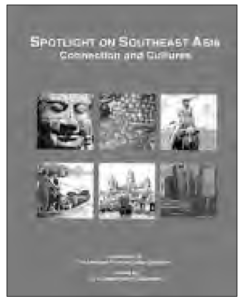 A Publication of the American Forum for Global Education, 2003
A Publication of the American Forum for Global Education, 2003
Funded by the US Department of Education
Project Director: Hazel Sara Greenberg
Consultants: Barbara Andaya (University of Hawai‘i), Michael Cullinane (University of Wisonsin–Madison), Richard O’Connor (University of the South), Peter Zinoman (University of California, Berkeley)
496 pages, 3-hole binder
Reviewed by Jason Jones
Whether cast as the scene of American defeat in the Vietnam War, an exotic crossroads of traditions and world cultures, or as the latest front in the War on Terrorism, Southeast Asia presents endless possibilities for the high school classroom. Aside from its compelling history, varied geography, and the otherworldly variety and vibrancy of its cultural landscape, the cultural, economic, and political dynamism of the region lends itself easily to any discussion of pertinent world issues like globalization, international trade, environmentalism, ethnic violence, and terrorism. In the aftermath of the terrorist attacks of September 11, 2001, youth in high schools across America are yearning for tools that enable them to place the heady events of the past three years into a context they can understand. Southeast Asia as a subject, through its diversity of peoples, cultures, religions, and experiences, offers both teacher and student an array of opportunities to identify, discuss, contextualize, and gain an understanding of important global issues while learning about and making connections with fascinating places few Americans know anything about.
Spotlight on Southeast Asia: Connections and Cultures is a large, comprehensive curriculum packet designed for use in the high school classroom. The material presented touches upon everything from Southeast Asian prehistory to the experiences of Southeast Asians who are now full fledged members of American society. The volume begins with a valuable teacher’s guide that outlines main themes and explains various strategies (e.g., tapping prior knowledge skills, vocabulary, writing, review, and involvement) to put to use in teaching the material. The materials themselves represent a well rounded collection of Southeast Asia scholarship, with the inclusion of many impressive articles and many well known authors.
One immediate observation was that I had read much of the material before as part of my undergraduate Southeast Asian Studies curriculum. That most of the material presented in this package is gleaned from books written for a college level audience highlights the fact that few materials on Southeast Asia have been developed specifically for students in grades K–12. This can make a good percentage of the material included in Spotlight on Southeast Asia difficult to use with all but the brightest high school upperclassmen. While I agree that inclusion of certain passages from Joel Steinberg’s In Search of Southeast Asia and influential articles written by Peter Bellwood could further a gifted young scholar’s understanding of the forces at work behind the contemporary face of the region, the real strength of this package, and the real potential to engage students who have no previous knowledge of Southeast Asia, lies in less ‘academic’ articles like Suzanne Brenner’s Javanese Women and the Muslim Veil (p. 432). This engaging article features the voice of a Javanese teenager sharing the process of making important life decisions about her appearance, her convictions, and her faith—subjects that resonate strongly with teenagers and that easily form the basis for further discussion on contemporary Indonesia, women’s rights, and/or Islam.
Other sections, particularly Identity: Southeast Asians in America and Age of Global Encounters: 15th to 18th Centuries, offer perspectives not always well represented in traditional American social studies curricula. Of particular quality are readings recounting the harrowing experiences of Indochinese refugees (e.g., Hmong in America, p. 88 and A Cambodian Refugee, p. 78), the entire case study of Spanish colonialism in Philippines (p. 282–310) and a well written piece explaining the current state of Southeast Asian economies (p. 420).
The introductory letter from Project Director Hazel Greenberg states, “We also understand this is not a textbook. Instead, it is a collection of supplemental readings which will bring another dimension to learning about Southeast Asia.” This is an accurate description. This project includes an impressive, relevant, and well organized body of knowledge. A great deal of material lends itself easily to general classroom discussions on more familiar topics such as world history, colonialism, gender roles, globalization, transnational migration, and international monetary policy.
However, I see real challenges to fusing much of the other highly specialized material to existing high school curriculum. Some material might be too esoteric to appeal to teachers and students unfamiliar with Southeast Asia. While some of the aforementioned articles would work well in conjunction with other lessons included in a more general Global or Social Studies curriculum, more accessible material is needed for teachers to be able to present Southeast Asia to all grades and all learning capacities. As a twelve-year-old, I specifically remember the engaging pictures and simple writing found in my parents’ crumbling stacks of Life and National Geographic magazines piquing and sealing my strong interest in the region. In light of this experience, I know that in order to create the same feelings about this region that I experienced in grade school, my real need as a program director is to find a visually engaging, simply written, up to date textbook on Southeast Asia to use in a middle or high school setting. Until I am able to find such a resource, Spotlight on Southeast Asia: Connections and Cultures presents itself as a comprehensive and thoughtfully constructed alternative.

